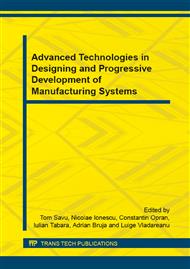[1]
M. Aurisicchio, R.H. Bracewell, G. Armstrong, The Function Analysis Diagram: intended benefits and co-existence with other functional models, Artificial Intelligence for Engineering Design, Analysis and Manufacturing, Vol. 27, No. 3 (2013).
DOI: 10.1017/s0890060413000255
Google Scholar
[2]
J. Hirtz, R. Stone, D. McAdams, S. Szykman, K. Wood, A Functional Basis for Engineering Design: Reconciling and Evolving Previous Efforts, Research in Engineering Design, Vol. 13 (2002) 65-82.
DOI: 10.1007/s00163-001-0008-3
Google Scholar
[3]
C. Kirschman, G. Fadel, Classifying Functions for Mechanical Design, Transactions of the ASME, J. of Mechanical Design, Vol. 120 (1998) 475-482.
DOI: 10.1115/1.2829176
Google Scholar
[4]
A. Visan, N. Ionescu, Tolerances: basis of design and prescription of products precision, ISBN 973-648-280-4, Bren, Bucharest, (2006).
Google Scholar
[5]
G. Pahl, W. Beitz, Engineering Design: A Systematic Approach, 2nd Edition, ISBN: 978-3540199175, Springer-Verlag GmbH, (1996).
Google Scholar
[6]
S.B. Tor, S.G. Lee, G.A. Britton, W.Y. Zhang, Knowledge-based functional design of industrial robots, Int. J. of Production Research, Vol. 46 (2008) 4501-4519.
DOI: 10.1080/00207540600864322
Google Scholar
[7]
A. Chakrabarti, T.P. Bligh, A scheme for functional reasoning in conceptual design, Design Studies Vol. 22, Issue 6 (2001) 493–517.
DOI: 10.1016/s0142-694x(01)00008-4
Google Scholar
[8]
P.E. Vermaas, K. Dorst, On the conceptual framework of John Gero's FBS-model and the prescriptive aims of design methodology, Design Studies, Vol. 28, Issue 2 (2007) 133-157.
DOI: 10.1016/j.destud.2006.11.001
Google Scholar
[9]
A. Bonaccorsi, R. Apreda, G. Fantoni, A theory of the constituent elements of functions, Proceedings of ICED 0, Design Theory and Design Methodology, CA, USA, Vol. 2 (2009) 179-190.
Google Scholar
[10]
R. Xiao, Y. Zu, S. Mei, Creative product configuration design driven by functional features, J. of Manufacturing Systems, Vol. 31 (2012) 69-75.
DOI: 10.1016/j.jmsy.2011.04.002
Google Scholar
[11]
M. Gheorghe, Engineering and Management of Production Processes 1, Course Notes, University POLITEHNICA of Bucharest, (2014).
Google Scholar
[12]
EN 10250-2: 2000: Open steel die forgings for general engineering purposes. Non-alloy quality and special steels.
DOI: 10.3403/02106726
Google Scholar


